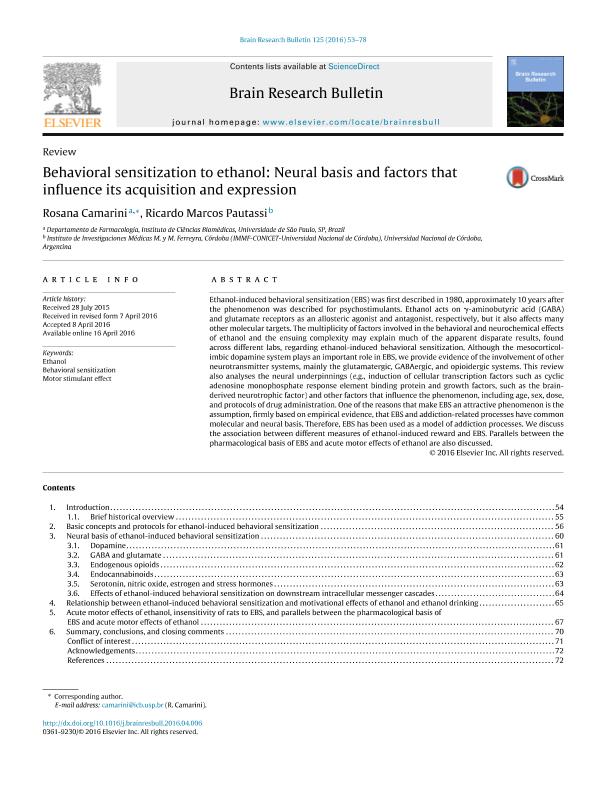Mostrar el registro sencillo del ítem
dc.contributor.author
Camarini, Rosana
dc.contributor.author
Pautassi, Ricardo Marcos

dc.date.available
2019-05-20T17:51:37Z
dc.date.issued
2016-07
dc.identifier.citation
Camarini, Rosana; Pautassi, Ricardo Marcos; Behavioral sensitization to ethanol: Neural basis and factors that influence its acquisition and expression; Pergamon-Elsevier Science Ltd; Brain Research Bulletin; 125; 7-2016; 53-78
dc.identifier.issn
0361-9230
dc.identifier.uri
http://hdl.handle.net/11336/76715
dc.description.abstract
Ethanol-induced behavioral sensitization (EBS) was first described in 1980, approximately 10 years after the phenomenon was described for psychostimulants. Ethanol acts on γ-aminobutyric acid (GABA) and glutamate receptors as an allosteric agonist and antagonist, respectively, but it also affects many other molecular targets. The multiplicity of factors involved in the behavioral and neurochemical effects of ethanol and the ensuing complexity may explain much of the apparent disparate results, found across different labs, regarding ethanol-induced behavioral sensitization. Although the mesocorticolimbic dopamine system plays an important role in EBS, we provide evidence of the involvement of other neurotransmitter systems, mainly the glutamatergic, GABAergic, and opioidergic systems. This review also analyses the neural underpinnings (e.g., induction of cellular transcription factors such as cyclic adenosine monophosphate response element binding protein and growth factors, such as the brain-derived neurotrophic factor) and other factors that influence the phenomenon, including age, sex, dose, and protocols of drug administration. One of the reasons that make EBS an attractive phenomenon is the assumption, firmly based on empirical evidence, that EBS and addiction-related processes have common molecular and neural basis. Therefore, EBS has been used as a model of addiction processes. We discuss the association between different measures of ethanol-induced reward and EBS. Parallels between the pharmacological basis of EBS and acute motor effects of ethanol are also discussed.
dc.format
application/pdf
dc.language.iso
eng
dc.publisher
Pergamon-Elsevier Science Ltd

dc.rights
info:eu-repo/semantics/openAccess
dc.rights
Atribución-NoComercial-CompartirIgual 2.5 Argentina (CC BY-NC-SA 2.5 AR)
dc.rights.uri
https://creativecommons.org/licenses/by-nc-sa/2.5/ar/
dc.subject
Behavioral Sensitization
dc.subject
Ethanol
dc.subject
Motor Stimulant Effect
dc.subject.classification
Salud Ocupacional

dc.subject.classification
Ciencias de la Salud

dc.subject.classification
CIENCIAS MÉDICAS Y DE LA SALUD

dc.title
Behavioral sensitization to ethanol: Neural basis and factors that influence its acquisition and expression
dc.type
info:eu-repo/semantics/article
dc.type
info:ar-repo/semantics/artículo
dc.type
info:eu-repo/semantics/publishedVersion
dc.date.updated
2019-04-15T18:14:42Z
dc.journal.volume
125
dc.journal.pagination
53-78
dc.journal.pais
Estados Unidos

dc.description.fil
Fil: Camarini, Rosana. Universidade do Sao Paulo. Instituto de Ciencias Biomedicas; Brasil
dc.description.fil
Fil: Pautassi, Ricardo Marcos. Consejo Nacional de Investigaciones Científicas y Técnicas. Centro Científico Tecnológico Conicet - Córdoba. Instituto de Investigación Médica Mercedes y Martín Ferreyra. Universidad Nacional de Córdoba. Instituto de Investigación Médica Mercedes y Martín Ferreyra; Argentina
dc.journal.title
Brain Research Bulletin

dc.relation.alternativeid
info:eu-repo/semantics/altIdentifier/url/http://www.sciencedirect.com/science/article/pii/S0361923016300806?np=y
dc.relation.alternativeid
info:eu-repo/semantics/altIdentifier/doi/http://dx.doi.org/10.1016/j.brainresbull.2016.04.006
Archivos asociados
